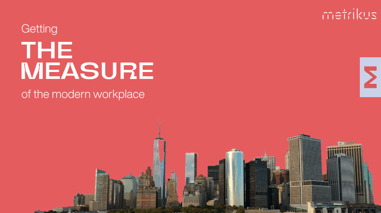Reducing noise pollution in the office
Workplaces are becoming smarter, with a growing number of offices implementing sensors that can monitor occupancy, capacity, light, temperature...the list goes on.
However, one aspect of the workplace is being left behind: they’re simply too loud, and the noise is harming our productivity.
In this blog post, we provide some top tips for reducing noise pollution, from updating your office layout to providing flexibility with remote working.
The problem with noise pollution in the office
There’s an abundance of scientific research behind why excessive noise harms our concentration. At best, background noise is an irritating distraction – at worst, it has detrimental effects on our mental and physical health. When turning our attention to workplace environments, the biggest problem is how much noise pollution harms employee productivity.
In office environments we’re surrounded by constant internal distractions such as conversations and ringing phones. Workplaces aren’t immune to the sounds of the outside world either; traffic noise and building works can provide continuous, distracting noise throughout the workday.
The pandemic has forced more of us to work remotely, but depending on individual setups, working from home is rarely a silent oasis. From noisy neighbours to working while a housemate cooks in the same room, it can be even harder to escape noisy distractions at home.
How does noise impact our productivity?
These distractions are harming workplace productivity: noise pollution in the workplace impacts the concentration and productivity of 69% of employees globally. Distractions also prove to be more damaging for those of us who have a tendency to multitask. Studies have shown that when their concentration is interrupted – by an instant message, overhearing a conversation, a phone ringing – multitaskers take longer to return to focusing on the task in hand.
When studying the effects of sound, psychologist Nick Perham found that background office noise significantly reduced participants’ ability to recall information and carry out maths exercises. As well as affecting productivity, excessive noise can cause workers to make more mistakes, meaning more time is wasted on correcting preventable errors.
Noise pollution causes physiological responses that decrease employee performance even further. Loud, excessive noise in short bursts or for a long period (such as ongoing building works) can put our bodies through unnecessary stress responses, causing increased heart rate, blood pressure and cortisol levels. Even if we try (and succeed in) blocking this noise out, it’s extremely tiring. We’re wasting energy on blocking out noise that isn’t serving us, when we could be putting this energy to better use.
Are open plan offices simply too noisy?
As the preference for open plan offices has grown in recent decades, the design choice has taken a toll on productivity. You can take a look at our Ultimate Guide to Workplaces to learn more about the role of smart devices in the work environment, and how workplaces have changed over the years.
These sleek spaces with reflective, easy to clean surfaces and open floors create echoes, and cause sound to be reflected more effectively. Studies have shown office workers to be up to 66% less productive in an open plan office, compared to individual workspaces.
The obvious response to the noise issue is to simply wear headphones to mask the background noise. However, go-to audio material – such as podcasts or lyric-filled songs – consumes even more concentration and just transfers the distraction issue.
Where open plan offices were previously heralded as ideal for collaboration and communication, employees are now forced to seek alternative spaces to concentrate, such as taking outdoor walks or working in coffee shops.
How can we reduce noise pollution in offices?
1. Update your office layout
The first port of call is to change your office layout. By creating more quiet, individual working spaces employees will have areas to go to when they feel their productivity lagging. Integrating high partitions will give the illusion of private areas and prevent sound from travelling as far if restructuring the entire floor isn’t possible.
2. Insulate the office windows
Additionally, windows should be insulated properly to reduce outside noise, especially if your office is in the middle of a busy city. Obviously a degree of internal noise is to be expected within any built environment, so implementing acoustic panels in the ceiling and walls will absorb some of this excess sound.
3. Biophilic design in the workplace
Another design change to consider is biophilic design. This architectural approach aims to bring the outdoors in by integrating natural elements throughout the interior landscape. This includes natural lighting, windows with outdoor views, and plants. The design is consistent across the entire built environment, rather than creating one designated ‘green’ area.
There are a number of health and wellbeing benefits of this design, but the one we’re most interested in is the connection between biophilic design and sound. Integrating green walls and standing plants can reduce noise pollution in the built environment by deflecting and diffusing sound.
The natural features need to be spread evenly throughout the office to be work: placing plants between workers, on cabinets, and as part of green walls are all effective. The design needs to be carefully considered to maximise its benefits, but it’s definitely worth considering if noise pollution is an issue in your workplace.
If you’re interested in the benefits of a green workspace, read our COO Michael Grant’s article about why we should be adding plants to our offices.
4. Providing flexibility with remote working
A simple, lower-cost method going forward is to give your employees the freedom to choose their environment. For instance, if building works are planned in advance opposite the office, it’s wise to inform your workforce of this and give them the opportunity to work remotely instead. Likewise, if an individual is suffering from excessive noise at home they should have the freedom to travel into the office last minute. Flexibility is key.
How can we increase productivity when working remotely?
If you’re working from home for the foreseeable future or have decided to go remote more often than before the pandemic, there are some easy ways to improve the noise pollution in your home.
The most effective way to reduce noise will be soundproofing rooms through insulation, double glazed windows, and sealing internal doors properly – but this can be incredibly costly (not to mention the excess noise caused by the construction of these changes). Heavy curtains, blankets and cushions can all absorb sound effectively, and bookshelves and cabinets are simple ways to break up sound-waves in the room.
If you really can’t avoid a noisy environment, put on headphones – but try listening to ambient soundscapes (think the whale noises, rainforest tracks, and classical music) instead of your favourite podcasts or lyric-heavy music.
Want to find out more about how we can make workplaces more productive? Check out our magazine, The Measure.




